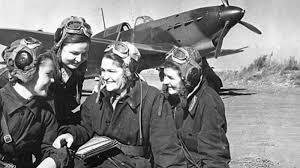The Night Witches of World War II
jmp.press@gmail.com
There’s been much discussion recently about World War II in general and the D-Day invasion in particular. As well there should be. We don’t speak German today because of the victory our parents …
This item is available in full to subscribers.
Subscribe to continue reading. Already a subscriber? Sign in
Get 50% of all subscriptions for a limited time. Subscribe today.
Please log in to continueNeed an account?
|
The Night Witches of World War II
jmp.press@gmail.com
There’s been much discussion recently about World War II in general and the D-Day invasion in particular. As well there should be. We don’t speak German today because of the victory our parents and grandparents won 75 years ago.
That conflict was a multi-front war. As terrible as it was for the U.S. with approximately 420,000 deaths, it was far worse for Russia, whose combined military and civilian death toll was 24 million. Let that number sink in for a minute. For every American who died in WWII, 57 Russians perished.
Repugnant as their Communist government was, the individual heroism displayed by everyday Russians during the war was truly remarkable. Historians are just starting to recognize part of the credit for the Allies’ triumph belongs to some women nicknamed the Night Witches.
Their official designation was the 588th Night Bomber Regiment, a pioneering group of all-female combat pilots. Their story began out of desperation.
The Nazi’s surprise invasion in June 1941 seriously crippled Soviet Russia’s military machine, pushing the Reds all the way to Leningrad (today’s St. Petersburg) and the outskirts of Moscow. A woman named Marina Raskova, called the “Soviet Amelia Earhart,” was a famous aviatrix. Russian women bombarded her with letters begging permission to take to the air and fight the Nazi invaders. Many had lost fathers and brothers or husbands and fiancés and were eager to avenge them.
Raskova appealed directly to dictator Josef Stalin, who approved the creation of three all-women air force units. It was the first time in world history that women actually fought in the sky. Raskova selected 400 fliers from over 2,000 applicants and plunged them into a crash training course of only a few weeks. Each was given a hand-me-down uniform designed for men, forcing them to stuff rags into their boots so their smaller feet could fit.
Their aircraft weren’t much better. The women were assigned outdated 1920 model open two-seater biplanes designed for crop-dusting. Their plywood construction made one writer call them “a coffin with wings.” They flew at night in Russia’s sub-freezing winter with nothing to protect them from the elements. It was so cold, simply touching the planes could remove bare skin. The aircraft were so lightweight they couldn’t carry such “luxuries” as guns, compasses, flashlights, maps, or even parachutes.
But they also had several key advantages. Their plywood design made them invisible to German radar. And their incredibly slow pace was below the Luftwaffe’s stall speed, making it easier for the women to maneuver their way out of trouble without being hit by gunfire.
Every night, 40 two-women crews were sent up. They would bomb a target, return to rearm, and fly off for another strike. Each plane made 15 to 18 bombing runs each night.
Incredibly, those bombs hit their targets. A total of 23,000 tons of explosions were dropped on the Nazis. It caused so much destruction the Germans scornfully called them Die Nachthexen—The Night Witches. Without radios in their cheap, flimsy planes they flew in communication silence like witches. The Germans also said the low flying approaching planes made a whooshing sound, like a witch’s broom sweeping a floor. The Night Witches became such a serious threat, any German who shot one down was automatically awarded the prestigious Iron Cross medal.
They flew for the final time on May 4, 1945, striking targets 37 miles from Berlin. Germany surrendered three days later. When all was said and done, the Night Witches flew over 30,000 missions, about 800 flights per pilot. A total of 30 women were killed; another 24 were named Hero of the Soviet Union, Communist Russia’s highest honor. Founder Raskov didn’t make it to the end; she was killed in 1943 and received the Soviet’s first state funeral of the war.
The women who did so much to defeat Hitler suffered one last indignity. They weren’t included in the huge victory parade through Moscow’s Red Square. The reason? Their 25 year-old biplanes were too slow to keep up with modern Russian warplanes.
And so they flew off into obscurity, a handful of women who earned the same praise Winston Churchill famously gave his country’s airmen on the other side of the continent: “Never was so much owed by so many to so few.”
Have comments, questions or suggestions you’d like to share with Mark? Message him at jmp.press@gmail.com .
Keywords
holy cow history, history, night witches, WWII, World War IIOther items that may interest you







Comments
No comments on this item Please log in to comment by clicking here